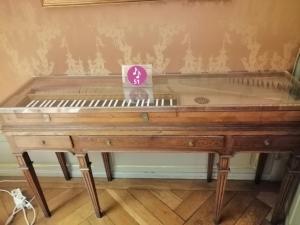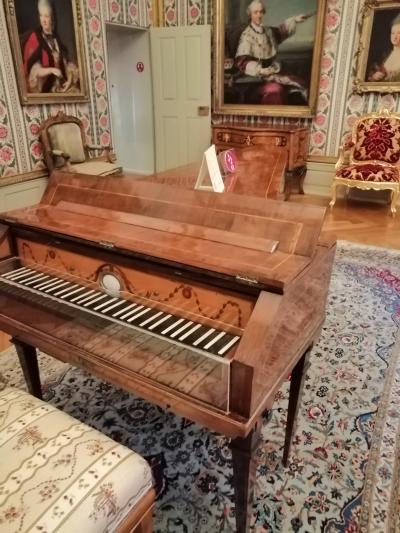The Forerunner of modern piano -- the Clavichord
In the 12th century the Monochord was provided with several strings of the same length in order to accompany the polyphonic singing. The equipment of the chromatic keyboard is derived from the organ and has been used since the middle of the 12th century.
 The Clavichord. The frame and chest are made according to the style of Louis XVI. The strings are arranged diagonally, the tuning peg is to the right of the soundboard. The keyboard ranges from C-g3, the coat of string is made of brass. The Instrument is restored in 1931 and can be played.
The Clavichord. The frame and chest are made according to the style of Louis XVI. The strings are arranged diagonally, the tuning peg is to the right of the soundboard. The keyboard ranges from C-g3, the coat of string is made of brass. The Instrument is restored in 1931 and can be played.
These early clavichords*1 already have the rectangular box shapes with an inserted keyboard. All strings are of equal length and tuned. The pitch is reached by brass pins, which are attached to the rear end of the key, striking different points of the string. The right part of the string is made to sound, the left part is muffled by braided felt band. The first illustration of such clavichord can be found at the beginning of 16th century, drawn by Sebastian Virdung, Musica, Basel at 1511.
________________________________________________________________________
From the beginning of the 15th century the clavichords were also built in two courses, i.e there were two strings for one tone. All instruments are manufactured in the so-called "bound system", in which there are far fewer strings than keys. C and C#, D and D# etc. are struck on a string by various tangents. These first instruments had only 20 to 22 keys.
At the beginning of the 16th century, the keyboard expanded to 3 octaves with 38 keys and 26 strings, in the 17th century to 4 octaves with 45 keys and 29 strings, in the 18th century to 4 octaves with 49 keys and 31 strings. The strings are no longer the same length, but are tuned chromatically.

The Hammerflügel (fortepiano) made by Jean Louis Dulcken (1761-1835) in Munich at 1789. He was the royal fortepiano maker of Electoral Prince Carl Theodor
Until the 16th century, the clavichord was a box-shaped instrument that could be placed anywhere, now got its own feet, but remained detachable from the frame and thus mobile. If the clavichord was in its heyday in the 18th century, clavichord construction was abandoned at the beginning of the 19th century. The instrument, which was primarily built in Germany, was used particularly as teaching and practicing instrument because it can produce peculiar shades of tone that are impossible with the harpsichord.
Historically, clavichord can be seen as the forerunner of the Fortepiano, which in its early days corresponded to both external shape and the type of stringing and string arrangement.
*1 clavis=keys, chorda=the strings
Source: Kurpfälzische Musuem Heidelberg, Germany
Photos by author